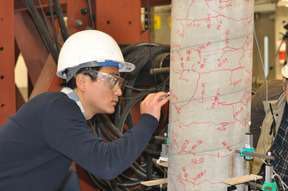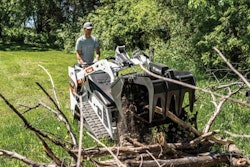 Student Peng Zhang traces cracks in the column during a strength test in UBC Okanagan’s Applied Laboratory for Advanced Materials and Structures. Photo credit: UBC Okanagan.
Student Peng Zhang traces cracks in the column during a strength test in UBC Okanagan’s Applied Laboratory for Advanced Materials and Structures. Photo credit: UBC Okanagan.A recent study of bridge types and their design requirements conducted by researchers at the University of British Columbia (UBC) Okanagan concluded that, in building bridges to withstand the force of an earthquake, they are being overbuilt, driving up construction costs.
“We’ve determined it’s very unnecessary to design a structure with that much reinforcement,” UBC professor Shahria Alam, the study’s author, said in a UBC news release posted to phys.org. “The code calls for a lot of material, and the size of the columns and beams are simply too large.”
The Canadian Highway Bridge Design Code addresses load, durability and seismic design—how movement during an earthquake will be dispersed within the structure so it will remain standing.
Alam isn’t suggesting that bridges be built without seismic performance in mind. Instead the research team is working to develop new materials that provide reinforcement in a more cost-efficient way.
“Public safety is the most important aspect, and we have to build structures so they do not collapse during an earthquake,” Alam told the news agency. “What we’re saying now is that we should be building structures that not only save lives, but we should also be saving the structure itself.”
The researchers have been testing the seismic performance of shape memory alloy reinforced and post-tensioned bridge piers, in the Applied Laboratory for Advanced Materials and Structures (ALAMS).
“We’ve proposed target residual drift-based criteria for performance-based seismic design of bridges that have self-centering capability,” Alam told the news agency. “It is very expensive to build a bridge to a certain standard, and then you cannot afford to demolish and replace it. Hence, new structural systems can be designed by following the proposed guideline. Thus, engineers can build almost damage-free bridges even after a major earthquake.”










